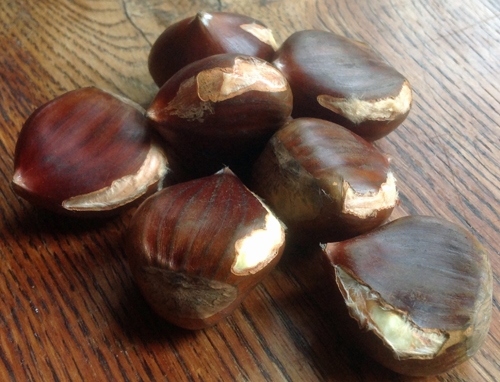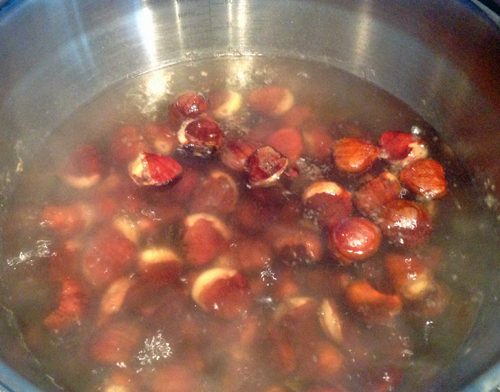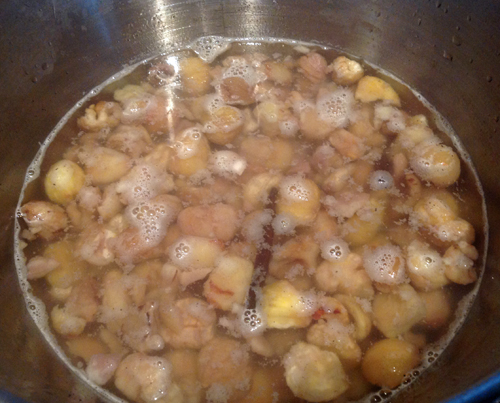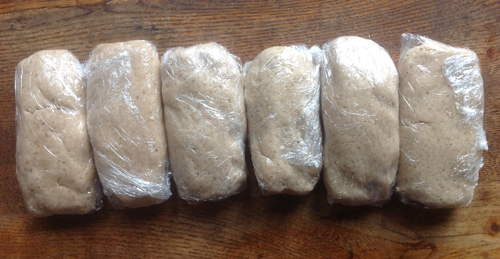I admit it. I do go a little crazy at this time of year. As soon as the new chestnuts are available in the market and invariably on special offer, I begin buying them. There are always some in my shopping cart. Yet, it never ceases to surprise me that – after a while – I have accumulated a mound of fresh chestnuts stored in the refrigerator. Yes, we roast them for Christmas, but there are only so many one can eat. So…often they are popped into the freezer to be dealt with later. Only then do I find yet more I had stashed there earlier – a vague “earlier” since I have not dated the packets.
What to do with this plethora of chestnuts? I love maron glacé, chestnuts slowly poached in a vanilla syrup where they almost become candy. But, this is a long and tedious process that tries my kitchen patience. Also, most of my chestnuts tend to disintegrate into small pieces in peeling or poaching – thereby creating a null result on maron glacé making. But, the process gave me the idea of creating my own sweet chestnut purée. Now, this can be purchased in expensive little tins, but homemade is much more economical, easy to make and just as yummy (if not more so). I use it in all sorts of desserts, often in the simple form of the classic Monte Blanco -simply a mound made by extruding threads of sweet chestnut purée topped with cream or a dusting of powdered sugar to resemble the snow capped Alpine mountain it is named after.
Sweet Chestnut Purée
Depending on how many chestnuts you have, the quantities can be multiplied (or divided).
Makes about six 250g packets
- 1kg sweet chestnuts
- 1 litre water
- 500g caster sugar, vanilla sugar or a combination of the two
- 1 vanilla pod or 1 teaspoon good quality vanilla extract
First put score the chestnut shells with a sharp knife or slice down one ridge along the side.
Put the chestnuts into a large heavy bottom pot and cover with water. Bring to a boil and let them cook for about 10 minutes.
Take off the heat. Remove a few chestnuts from the pot at a time to shell and peel off the dark skin surrounding the chestnut flesh. Leave the rest of the chestnuts in the hot water until you are ready to shell and peel more. Some may break up into pieces and some bits of skin may cling, but don’t worry about it at this stage. Set these aside in a bowl while you make the light syrup.
Put the 500ml of water, the sugar and a split vanilla pod or the vanilla extract in a large heavy bottom pot. Bring to a boil and let it cook for a few minutes until it forms a light syrup. Add the chestnut pieces, stir and lower the heat.
Let this simmer for 2 to 2-1/2 hours until the chestnuts begin to disintegrate, stirring every so often to prevent them from sticking to the bottom of the pot. You may need to stir more frequently near the end as the mixture thickens. Turn off the heat when the chestnuts are very soft and have partly reduced to a pulp.
Let the chestnuts cool, remove the vanilla pod (if using), and then purée it in a food processor, adding a little water if it is too thick.
Press the purée through the fine-holed plate on the food mill (mouli) to get a finer texture and to remove all those little pieces of dark skin that didn’t come off in the initial peeling.
Wrap tightly in clingfilm in packets of 250g and further place in a plastic container or bag to be frozen until required.










We enjoyed this dish so much when we lived in France and Switzerland. Thanks for the reminder.
LikeLike
The sweet chestnut purée is so useful to have around, and look at all the lovely French (Swiss, Italian) sweets you can make with it. Definitely a reminder of those places.
LikeLike
Wonderful post. I also tend to accumulate food, especially herbs or fava beans, but not chestnuts, as I know I am way too lazy to spend hours peeling them. I love chestnut purée, but here in France the tins cost nothing, so I’ve always got one lying around in case I need it. I should make it myself and compare the results. As to disintegrated marrons glacés, I suggest you take a look at my latest recipe, which calls exactly for that 🙂
LikeLiked by 1 person
Loved you post using the bits of disintegrating maron glacé. You are so lucky to have access to inexpensive tins of this stuff. We can, of course, buy imported French purée in tins, but at vastly inflated prices. One of the reasons I love shopping when we are in France! My suitcase is always chock full of edible things.
LikeLike
Most useful, thank you !!!!!!
LikeLike
Something to do with a friend or two as the peeling is rather tedious. Luckily there was a good programme on the radio when I was doing this!
LikeLike
Your delightful kitchen witch hard work is always inspiring. Whilst we don’t see chestnuts here this time of year, I will have to remember this and bookmark it for our winter.
LikeLike
Ah, that alternate hemisphere seasonal problem again! I don’t think I will ever get used to the idea of Christmas in summer. Save the idea for when chestnuts come your way!
LikeLiked by 1 person
What a unique recipe. I’ve never seen anything like this. I’d love to try this. What different directions we took the chestnuts in! I so need to try this. Quick question, how do you get from those wrapped up packages to the final picture. What kind of fine-holed plate do you use?
LikeLike
The purée is quite thick and can be moulded and wrapped into those little clingfilm (Saran Wrap) packets quite easily. I use a mouli, otherwise known as a food mill (http://en.m.wikipedia.org/wiki/Food_mill). It has a holed plate that the food is pressed through. My food mill came with two separate plates with different diameter holes. I used the finer of the two. It is easier than trying to press it through a fine sieve and it achieves a similar fine texture. I use the purée in desserts, cakes, etc. I am also experimenting with a gelato (naturally!). It is a great ingredient to have around.
LikeLike
Oh, forgot to add that to make Monte Bianco (or French Mont Blanc), I simply put the purée into my potato ricer and extruded the mound. There is a French version that mounds this on a meringue nest with a dollop of cream and then drizzles dark chocolate sauce over the lot. Yum!
LikeLike
Great minds think alike… I just posted a chestnut cake recipe, mont blanc, which also includes boiled chestnuts in sugar syrup. 🙂
LikeLike
Loved your recipe! you made the brown purée look beautiful – a definite feat! I have to add this to my list of chestnut purée recipes.
LikeLiked by 1 person
I’ve only ever used chestnut puree once, an expensive French can. I used it in a chocolate dessert which was sublime. This looks like the sort of thing that could be simmering away while the cook does other things in the kitchen. I’m filing this for next autumn, then I’m going to do some experimenting. Thanks Deb!
LikeLike
Certainly it can simmer away unattended for quite some time. The peeling is the horrid part, but if you have company, or a good radio programme or even some music, the task goes quickly. In the end, you have a great supply of purée. I love it with chocolate – a fantastic combination. I also wonder if it would react the same way as almond paste? Must try it in baking. The French imported tins are also very expensive and I rarely buy it – even less so now that I make my own.
LikeLike
certainly not easy to get chestnuts in sunny sub tropical queensland! but i do buy the french puree in a can. it is delicious.
LikeLike
It is a great ingredient! Luckily at this time of year in the UK, we get great chestnuts and if you wait for the specials, you can get them at very good prices. Makes it worth it as the imported French tins are expensive.
LikeLike
There’s a certain lady in Michigan that would love this! We’ve always enjoyed chestnuts around the holidays but only roasted. Your chestnut puree would be a big hit. I’ve got to give it a go. I’ve no food mill but I do have a Roma strainer that will work, I’m sure. If it can separate out strawberry seeds, it will work with chestnuts. Thanks for sharing your recipe. I’ll let you know how it goes 🙂
LikeLike
We roast them, too. In fact, one trip to Tuscany netted us a cast iron chestnut roaster for the fireplace.
LikeLike
Hit sent too soon! The chestnut purée is great, but I think it is best with boiled chestnuts which soften up the nut and don’t add any of that extra “nutty” flavour that you get from roasting. It is versatile in any number of sweet recipes – not least Monte Bianco. Also, it is produced at a fraction of the cost of those imported tins from France. Hope the “lady in Michigan” enjoys it!
LikeLike